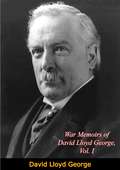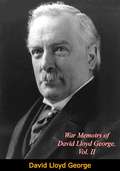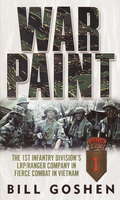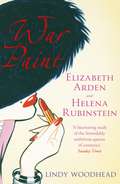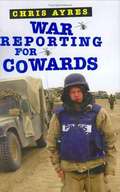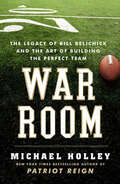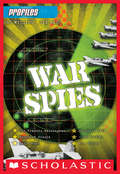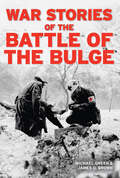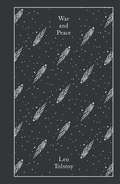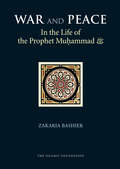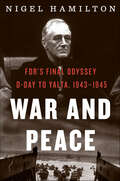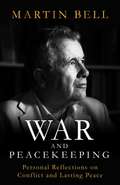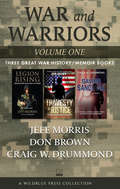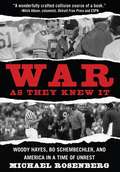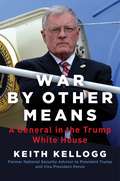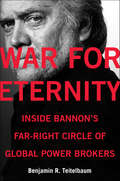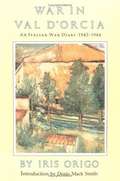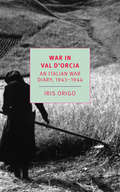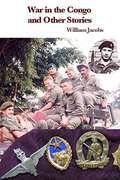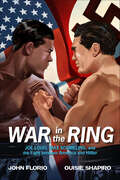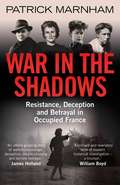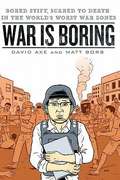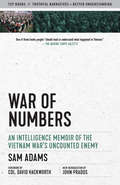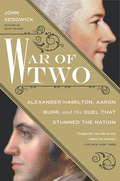- Table View
- List View
War Memoirs of David Lloyd George, Vol. I (War Memoirs of David Lloyd George #1)
by David Lloyd George“Mr. Lloyd George’s War Memoirs constitute a record of unfading historic interest….No one who wishes to be well informed about the Great War should fail to study them.”—Rt. Hon. Winston S. ChurchillA personal account of World War I events, as told from the perspective of David Lloyd George, former Chancellor of the Exchequer (1908-1915), Minister of Munitions (1915-1916), Secretary of State of War (1916) and, towards war end, Prime Minister of the United Kingdom (1916-1922).
War Memoirs of David Lloyd George, Vol. II (War Memoirs of David Lloyd George #2)
by David Lloyd GeorgeA personal account of World War I events, as told from the perspective of David Lloyd George, former Chancellor of the Exchequer (1908-1915), Minister of Munitions (1915-1916), Secretary of State of War (1916) and, towards war end, Prime Minister of the United Kingdom (1916-1922).“Mr. Lloyd George’s War Memoirs constitute a record of unfading historic interest….No one who wishes to be well informed about the Great War should fail to study them.”—Rt. Hon. Winston S. Churchill
War Paint
by Bill GoshenThe men who served with in the 1st Infantry Division with F company, 52nd Infantry, (LRP) later redesignated as Company I, 75th Infantry (Ranger) --engaged in some of the fiercest, bloodiest fighting during the Vietnam War, suffering a greater relative aggregate of casualties that any other LRRP/LRP/ Ranger company. Their base was Lai Khe, within hailing distance of the Vietcong central headquarters, a mile inside Cambodia, with its vast stockpiles of weapons and thousands of transient VC and NVA soldiers. Recondo-qualified Bill Goshen was there, and has written the first account of these battle-hardened soldiers. As the eyes and ears of the Big Red One, the 1st Infantry, these hunter/killer teams of only six men instered deep inside enemy territory had to survive by their wits, or suffer the deadly consequences. Goshen himself barely escaped with his life in a virtual suicide mission that destroyed half his team. His gripping narrative recaptures the raw courage and sacrifice of American soldiers fighting a savage war of survival: men of all colors, from all walks of life, warriors bonded by triumph and tragedy, by life and death. They served proudly in Vietnam, and their stories need to be told.
War Paint: Elizabeth Arden and Helena Rubinstein: Their Lives, their Times, their Rivalry
by Lindy WoodheadWar Paint is the story of two extraordinary women, Miss Elizabeth Arden and Madame Helena Rubinstein, and the legacy they left: a story of feminine vanity and marketing genius. Behind the gloss and glamour lay obsession with business and rivalry with each other. Despite working for over six decades in the same business, these two geniuses never met face to face - until now. 'The definitive biography of women and their relationships to their faces in the twentieth century' Linda Grant, Guardian'I have seldom enjoyed a book so much . . . the research is staggering . . . a wonderful read' Lulu Guinness
War Reporting for Cowards
by Chris AyresFrom the book: "Captain," I called out. -How dangerous is this going to be?" "Don't worry," he said with a straight face. "People think artillery is boring. But we kill more people than anyone else." Chris Ayres never wanted to be a war correspondent. A small-town boy, a hypochondriac, and a neat freak with an anxiety disorder, he saw journalism as a ticket to lounging by swimming pools in Beverly Hills and sipping martinis at Hollywood celebrity parties. Instead, he keeps finding himself in the wrong place at the wrong time, whether it's a few blocks from the World Trade Center on September 11 or one cubicle over from an anthrax attack at The New York Post. Then, a misunderstanding with his boss sees him transferred from Hollywood to the Middle East, where he is embedded with the Marine Corps on the front line of the Iraq War, headed straight to Baghdad with a super-absorbent camping towel, an electric toothbrush, and only one change of underwear. What follows is the worst (not to mention the first) camping trip of his life. War Reporting for Cowards is the Iraq War through the eyes of a "war virgin." After a crash course on "surviving dangerous countries" where he nearly passes out when learning how to apply a tourniquet, and a gas mask training exercise where he is repeatedly told he is "one very dead media representative," Ayres joins the Long Distance Death Dealers, a battalion of gung-ho Marines who kill more people on the battlefield than anyone else. Donning a bright blue flak jacket and helmet, he quickly makes himself the easiest target in the entire Iraqi desert. Ayres spends the invasion digging "coffin-sized" foxholes, dodging incoming mortars, fumbling for his gas mask, and, at one point, accidentally running into the path of a dozen Republican Guard tanks amid a blinding mud storm. By "bogged down" by the growing insurgency, Ayres realizes not only what the sheer terror of combat feels like, but also the visceral thrill of having won a fight for survival. In the tradition of M*A*S*H and Catch-22, War Reporting for Cowards is by turns extraordinarily honest, heartfelt, and bitterly hilarious. It is destined to become a classic of war reportage.
War Room: The Legacy of Bill Belichick and the Art of Building the Perfect Team
by Michael HolleyThe New York Times bestselling author delivers “a lively, fast-paced insider’s account” of what it takes to succeed in the NFL (Boston Globe). Football games aren’t won on Sundays in the fall. They’re won on draft day in the spring—in the war room. Now sports commentator and author Michael Holley takes readers behind the scenes of three NFL teams and into the brilliant minds of legendary coach Bill Belichick and his two former protégés, Thomas Dimitroff and Scott Pioli.Belichick first worked alongside Pioli and Dimitroff as a young coach in Cleveland. Years later, they were reunited in New England, where they refined Belichick’s method for constructing a winning team, overseeing one of the greatest franchises in modern NFL history.These three master strategists are now competitors, with Belichick at the helm of the New England Patriots, while Pioli leads the Kansas City Chiefs and Dimitroff runs the Atlanta Falcons. Yet they still share a common goal: building the perfect team, one draft pick and one trade at a time.War Room tells their astonishing story, packed with never-been-told anecdotes and new observations from team officials, players, coaches, and scouts, all leading to surprising and groundbreaking insights into the art of building a champion.
War Spies: War Spies (Profiles #7)
by Daniel PolanskySix bios in one!Six bios in one!Profiles is so much more than just your typical biography. The next book in our six-in-one, full-color bio series will focus on war spies. Kids will learn all of the biographical information they want to know about some of the most famous spies in history. Featuring Sir Francis Walsingham, Nathan Hale, Belle Boyd, Kim Philby, Virginia Hall, and Allen Dulles. Find out how and why they grew up to be spies!
War Stories
by Jeremy BowenHaving joined the BBC as a trainee in 1984, Jeremy Bowen first became a foreign correspondent four years later. He had witnessed violence already, both at home and abroad, but it wasn't until he covered his first war – in El Salvador – that he felt he had arrived. Armed with the fearlessness of youth he lived for the job, was in love with it, aware of the dangers but assuming the bullets and bombs were meant for others. In 2000, however, after eleven years in some of the world's most dangerous places, the bullets came too close for comfort, and a close friend was killed in Lebanon. This, and then the birth of his first child, began a process of reassessment that culminated in the end of the affair. Now, in his extraordinarily gripping and thought-provoking new book, he charts his progress from keen young novice whose first reaction to the sound of gunfire was to run towards it to the more circumspect veteran he is today. It will also discuss the changes that have taken place in the ways in which wars are reported over the course of his career, from the Gulf War to Bosnia, Afghanistan to Rwanda.
War Stories of the Battle of the Bulge
by Michael Green James D. Brown“Told by those who lived during . . . Hitler’s last gasp attack in the West . . . a riveting book for anybody with an interest in the Second World War.” —CurledUpThe powerful German counteroffensive operation codenamed “Wacht am Rhein” (Watch on the Rhine) launched against the American First Army in the early morning hours of December 16, 1944, would result in the greatest single extended land battle of World War II. To most Americans, the fierce series of battles fought in the Ardennes Forest of Belgium and Luxembourg that winter is better known as the Battle of the Bulge. Here are the first-person stories of the American soldiers who repelled the powerful German onslaught that had threatened to turn the tide of battle in Western Europe during World War II.
War and Peace (Penguin Clothbound Classics)
by Leo TolstoyAt a glittering society party in St. Petersburg in 1805, conversations are dominated by the prospect of war. Terror swiftly engulfs the country as Napoleon’s army marches on Russia, and the lives of three young people are changed forever. The stories of quixotic Pierre, cynical Andrey, and impetuous Natasha interweave with a huge cast, from aristocrats and peasants, to soldiers and Napoleon himself. In War and Peace, Tolstoy entwines grand themes—conflict and love, birth and death, free will and fate—with unforgettable scenes of nineteenth-century Russia, to create a magnificent epic of human life in all its imperfection and grandeur.
War and Peace in the Life of the Prophet Muhammad
by Zakaria BashierBy analyzing the Prophet's conduct in war and his measures for ensuring peace the misperception that Islam is inextricably linked with violence can be allayed. The major battles in the early history of Islam are studied in the wider context of Islamic teachings on war and peace, as are the Qur'anic verses which allow Muslims to wage war, if necessary.
War and Peace: FDR's Final Odyssey: D-Day to Yalta, 1943–1945 (FDR at War #3)
by Nigel HamiltonThe “gripping and powerfully argued” final volume in the acclaimed 3-part biography of FDR at war—proving that he was the key strategist of WWII (New York Times Book Review).Nigel Hamilton’s celebrated trilogy culminates with a story of triumph and tragedy. In the spring of 1944, FDR oversaw the historic success of the D-day landings he had championed, just as he was found to be mortally ill. Yet even in the face of his own mortality, Roosevelt was the architect of a victorious peace that he would not live to witness.Using hitherto unpublished documents and interviews, Hamilton rewrites the famous account of World War II strategy given by Winston Churchill in his memoirs. Seventy-five years after the D-day landings we finally get to see, close-up and in dramatic detail, who was responsible for rescuing, and insisting upon, the great American-led invasion of France in June 1944, and why the invasion was led by Eisenhower. As FDR’s D-day triumph turns to personal tragedy, we watch the course of the disease, and how the dying president attempted—at Hawaii, Quebec, and Yalta—to prepare the United Nations for an American-backed postwar world order. Now we know: even on his deathbed, FDR was the war’s great visionary.“A first-class, lens-changing work.” —James N. Mattis, former US secretary of defense
War and Peacekeeping: Personal Reflections on Conflict and Lasting Peace
by Martin BellThere are no winners in war, only losers. We have so far avoided a third world war, but across the globe regional conflicts flare up in a seemingly unstoppable cycle. Who can stand between the armed camps? Over six decades, Martin Bell has stood in eighteen war zones – as a soldier, a reporter and a UNICEF ambassador. Now he looks back on our efforts to keep the peace since the end of the Second World War and the birth of the United Nations peacekeeping mission in the new State of Israel. From the failures of Bosnia, Rwanda and South Sudan to nationalism&’s resurgence and the distribution of alternative facts across a darkening political landscape, Bell calls for us to learn from past mistakes – before it&’s too late.
War and Warriors Volume One: Legion Rising, Travesty of Justice, Saving Sandoval (War and Warriors #1)
by Don Brown Jeff Morris Craig W. DrummondThree real-life accounts of the struggles of American soldiers from the Iraq and Afghanistan battlefields to, in two cases, US military tribunals. Legion Rising: Surviving Combat and the Scars It Left Behind by Jeff Morris Follow Jeff through up-close, fast-paced accounts of the thrills and dangers of combat as a Platoon Leader in Iraq. Feel the weight of the gruesome and tragic loss of eight men whose lives were taken in the line of duty. Journey through his battle to face the scars and shadows that followed him long after his time serving in the military was over. Travesty of Justice: The Shocking Prosecution of Lt. Clint Lorance by Don BrownThe Book That Won a Presidential Pardon! On July 2, 2012, three Afghan males crowded on a motorcycle and sped down a Taliban-controlled dirt road toward Lt. Clint Lorance&’s men. In a split-second decision, Lorance ordered his men to fire. When no weapons were found on the Afghan bodies, the Army prosecuted Lorance for murder. &“The most powerful case to date for the exoneration of imprisoned Army Lt. Clint Lorance.&” —Sun-Sentinel Saving Sandoval by Craig W. Drummond While deployed in Iraq, Sandoval, an airborne infantryman and elite sniper, was instructed to &“take the shot&” and kill an enemy insurgent wearing civilian clothes. Two weeks later, Army Criminal Investigation Command descended upon Sandoval&’s unit, trying to link Sandoval and others to war crimes, including murder. &“A revealing, real-life courtroom drama, reminiscent of A Few Good Men.&” —Hunter R. Clark, International Law and Human Rights Program and Drake University Law School
War as They Knew It: Woody Hayes, Bo Schembechler, and America in a Time of Unrest
by Michael Rosenberg[From the front flap] The Vietnam War . . . Nixon . . . Kent State . . . The late 1960s and early 1970s were a time of total turmoil in America-the country was being torn apart by a war most people didn't support, young men were being taken away by the draft, and racial tensions were high. Nowhere was this turmoil more evident than on college campuses, the epicenters of the protest movement. The uncertain times presented a challenge to two of the greatest football coaches of all time. Woody Hayes, the legendary arch-conservative coach of Ohio State, feared for the future of America. His protege and rival, Bo Schembechler of the University of Michigan, didn't want to be bothered by these "distractions." Hayes worshipped General George S. Patton and was friends with President Richard Nixon. Schembechler befriended President Gerald Ford, a former captain and team MVP for the Wolverines. In this enthralling book, Michael Rosenberg dramatically weaves the campus unrest and political upheaval into the story of Hayes and Schembechler.
War by Other Means: A General in the Trump White House
by Keith KelloggGeneral Keith Kellogg saw it all. The only national security advisor to work side by side with both President Trump and Vice President Pence, he was their confidant as they made their most momentous decisions. No one knows better than he that the hysterical accusations of the administration&’s partisan detractors were unconnected to reality. Demolishing baseless caricatures of Donald Trump, General Kellogg provides one of the few reliable accounts of the administration from the earliest days of the 2016 campaign to the end of the president&’s term. Kellogg reveals: How Trump&’s &“America First&” policies strengthened the nation after Obama&’s eight-year apology tour Why the president&’s tough approach to China worked—and why future administrations must continue to take the China threat seriously How withdrawal from the Iran nuclear deal and the strike on General Soleimani slowed the spread of radical Islamist terror Why Democrats&’ appeasement policies are courting disaster for America and the world The radicals attacking President Trump&’s legacy are sacrificing sound policy to politics. Kellogg&’s account is an urgently needed reminder that politics is &“war by other means.&” Our enemies never forget that, and Americans forget it to their peril.
War for Eternity: Inside Bannon's Far-Right Circle of Global Power Brokers
by Benjamin R. TeitelbaumOne of Financial Times' Summer Books of 2020An explosive and unprecedented inside look at Steve Bannon's entourage of global powerbrokers and the hidden alliances shaping today's geopolitical upheaval.In 2015, Bloomberg News named Steve Bannon “the most dangerous political operative in America.” Since then, he has grown exponentially more powerful—and not only in the United States. In this groundbreaking and urgent account, award-winning scholar of the radical right Benjamin Teitelbaum takes readers behind-the-scenes of Bannon's global campaign against modernity.Inspired by a radical twentieth-century ideology called Traditionalism, Bannon and a small group of right-wing powerbrokers are planning new political mobilizations on a global scale—discussed and debated in secret meetings organized by Bannon in hotel suites and private apartments in DC, Europe and South America. Their goal? To upend the world order and reorganize geopolitics on the basis of archaic values rather than modern ideals of democracy, freedom, social progress, and human rights. Their strenuous efforts are already producing results, from the fortification of borders throughout the world and the targeting of immigrants, to the undermining of the European Union and United States governments, and the expansion of Russian influence. Drawing from exclusive interviews with Bannon’s hidden network of far-right thinkers, years of academic research into the radical right, and with unprecedented access to the esoteric salons where they meet, Teitelbaum exposes their considerable impact on the world and their radical vision for the future.
War in Val D'Orcia: An Italian War Diary, 1943-1944
by Iris Origo<p>A classic of World War II, here in its first American edition. War in Val d'Orcia is Iris Origo's elegantly simple chronicle of daily life at La Foce, a manor in a Tuscan no-man's land bracketed by foreign invasion and civil war. <p>With the immediacy only a diary can have, the book tells how the Marchesa Origo, an Anglo-American married to an Italian landowner, kept La Foce and its farms functioning while war threatened to overrun it and its people. She and her husband managed to protect their peasants, succor refugee children from Genoa and Turrin, hide escaped Allied prisoners of war-and somehow stand up to the Germans, who in dread due course occupied La Foce in 1944 and forced the Marchesa to retreat under a hot June sun. <p>Fleeing eight impossible miles on foot, along a mined road under shell fire, with sixty children in tow, she sheltered her flock in the dubious safety of a nearby village. A few days later, official Fascism disappeared, and La Foce was ransacked by the retreating Wehrmacht. Here, as the restoration of La Foce begins, her book ends. <p>Beyond praise and above mere documentary value, War in Val d'Orcia belongs to the literature of humanity.</p>
War in Val d'Orcia: An Italian War Diary, 1943-1944
by Virginia Nicholson Iris OrigoIn the Second World War, Italy was torn apart by German armies, civil war, and the Allied invasion. In a corner of Tuscany, one woman—born in England, married to an Italian—kept a record of daily life in a country at war. Iris Origo’s powerful diary, War in Val d’Orcia, is the spare and vivid account of what happened when a peaceful farming valley became a battleground.At great personal risk, the Origos gave food and shelter to partisans, deserters, and refugees. They took in evacuees, and as the front drew closer they faced the knowledge that the lives of thirty-two small children depended on them. Origo writes with sensitivity and generosity, and a story emerges of human acts of heroism and compassion, and the devastation that war can bring.
War in the Congo and Other Stories
by William Jacobs<p>William "Bill" Jacobs never backed down from adventure anywhere he found it. This book contains his personal record of some of the highlights of his life. It starts with his time in the British Parachute Regiment, then the bulk of the story tells of his two contracts, in 1966 and 1967, as a "mercenary" in the Congo where he was commissioned as a Lieutenant on his second contract. The book also includes a few anecdotes of such as his short-lived career as a crocodile hunter and some other vignettes. <p>No sensibilities are spared in his telling of the story. The style is clearly one of recollection as he consulted his diary lf the events, so much of the content has a sense of rawness and immediacy with reinforces the reality of this being a real story and not a made-for-Hollywood story.</p>
War in the Ring: Joe Louis, Max Schmeling, and the Fight between America and Hitler
by Ouisie Shapiro John FlorioWar in the Ring presents a riveting nonfiction book for kids about a boxing match that represented the growing tensions between the United States and Nazi Germany in the lead up to World War II.Joe Louis was born on an Alabama cotton patch and raised in a Detroit ghetto. Max Schmeling grew up in poverty in Hamburg, Germany. For both boys, boxing was a path out and a ladder up. Little did they know that they would one day face each other in a pair of matches that would capture the world's attention.Joe grew into a symbol of inspiration to a nation of Black Americans hoping to carve a slice of the 'American Dream' in a racially fractured country. Max, on the other hand, became a Nazi symbol for the superiority of the Aryan race. The battles waged between Joe and Max still resonate, and the cultural implications of the international sensation continue to reverberate far past the ring.
War in the Shadows: Resistance, Deception and Betrayal in Occupied France
by Patrick MarnhamIn 1962 the young Patrick Marnham set off by car for a small village in central France. There he was taught French by an imperious countess, who he later discovered had fought in the Resistance until, betrayed, she was sent to Ravensbrück concentration camp. On the very same day that his hostess&’s network was broken, Jean Moulin, de Gaulle&’s delegate as head of the combined Resistance forces, was arrested in Lyons, where he was tortured by Klaus Barbie before dying in Gestapo custody. Was this coincidence, or were these events connected? The anonymous letter writer suggested a key to the mystery. Using a knowledge of France gained from 12 years as the Independent&’s Paris correspondent, and subsequent research in archives in England and France, Marnham set out to discover the truth about the betrayal of the old lady who had become his tutor and friend. Following a trail leading from London through Occupied Europe to the rank and file Resistance in lost corners of France, he has unravelled the story of a complex wartime deception, involving British, American and French intelligence services. The War in the Shadows shines a light on the brutality and cynicism of the Secret War and reveals how it was actually fought. The result is a story of ruthless double-dealing worthy of John le Carré, but with this difference: it is not a fiction.
War is Boring
by David AxeThe war memoir as graphic novel-an utterly unforgettable and highly original look at war in the 21st century. Street battles with spears and arrows in sweltering East Timor. Bone- jarring artillery duels in Afghanistan's mountains. Long patrols on the sandy wastes of southern Iraq. For four years, war was life for David Axe. He was alternately bored out of his mind and completely terrified. It was strangely addictive. As a correspondent for The Washington Times, C-SPAN and BBC Radio, Axe flew from conflict to conflict, reveling in death, danger, and destruction abroad while, back in D. C. , his apartment gathered dust, his plants died, and his relationships withered. War reporting was physically, emotionally, and financially draining-and disillusioning. Loosely based on the web comic of the same name, with extensive new material, War Is Boring takes us to Lebanon and Somalia; to arms bazaars across the United States; to Detroit, as David tries to reconnect with his family-and to Chad, as David attempts to bring attention to the Darfur genocide. <P><P> <i>Advisory: Bookshare has learned that this book offers only partial accessibility. We have kept it in the collection because it is useful for some of our members. Benetech is actively working on projects to improve accessibility issues such as these.</i>
War of Numbers: An Intelligence Memoir of the Vietnam War's Uncounted Enemy (Eyewitness Memoirs Ser.)
by Sam AdamsIn vibrant, engaging prose, this memoir from inside the belly of US intelligence operations reveals what fundamentally went wrong for the US and its allies, and why the Vietnam War was never "winnable." A cautionary tale about the perils of politicizing and manipulating honest intelligence.For political reasons, the Johnson and Nixon administrations wanted to control the narrative about US prospects in Vietnam. In 1965, low level CIA analyst Sam Adams was transferred from the Congo desk to Southeast Asia, where he was charged with assessing enemy morale and counting their ranks. Only the enemy strength estimate he came up with as the CIA's official head counter varied wildly from the official estimates being produced by military intelligence and released by the White House for consumption by Congress, the media, troops in the field and the American electorate. Adams' findings pointed to the conclusion that the war was unwinnable, but when politicians and military leaders failed to release let alone acknowledge his findings, he knew the intelligence was being politicized and embarked on a one man crusade to hold those in power accountable and expose the truth.
War of Two
by John SedgwickA provocative and penetrating investigation into the rivalry between Alexander Hamilton and Aaron Burr, whose infamous duel left the Founding Father dead and turned a sitting Vice President into a fugitive. In the summer of 1804, two of America's most eminent statesmen squared off, pistols raised, on a bluff along the Hudson River. That two such men would risk not only their lives but the stability of the young country they helped forge is almost beyond comprehension. Yet we know that it happened. The question is why. In War of Two, John Sedgwick explores the long-standing conflict between Founding Father Alexander Hamilton and Vice President Aaron Burr. A study in contrasts from birth, they had been compatriots, colleagues, and even friends. But above all they were rivals. Matching each other's ambition and skill as lawyers in New York, they later battled for power along political fault lines that would not only decide the future of the United States, but define it. A series of letters between Burr and Hamilton suggest the duel was fought over an unflattering comment made at a dinner party. But another letter, written by Hamilton the night before the event, provides critical insight into his true motivation. It was addressed to former Speaker of the House Theodore Sedgwick, a trusted friend of both men, and the author's own ancestor. John Sedgwick suggests that Hamilton saw Burr not merely as a personal rival but as a threat to the nation. Burr would prove that fear justified after Hamilton's death when, haunted by the legacy of his longtime adversary, he embarked on an imperial scheme to break the Union apart.From the Hardcover edition.
